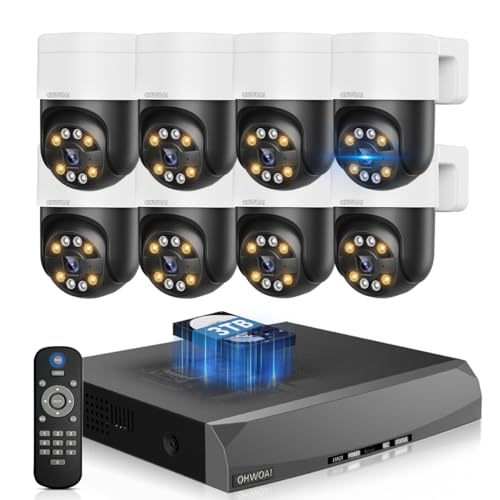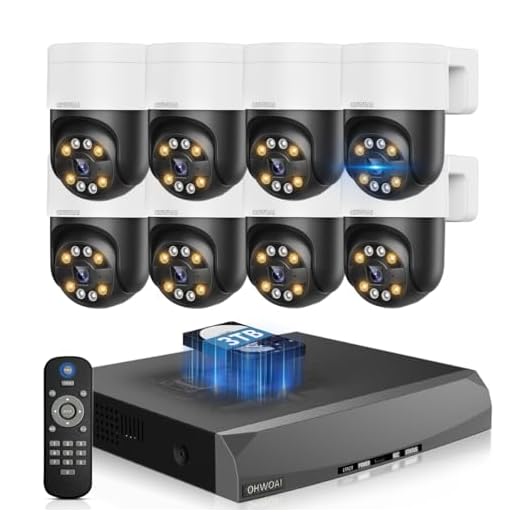


Panoramic security cameras are a crucial component of modern surveillance systems, providing a comprehensive view of a wide area from a single vantage point. These cameras utilize advanced technology to capture high-resolution images and videos, allowing for effective monitoring of large spaces.
The key feature of panoramic security cameras is their ability to create a 360-degree view, eliminating blind spots and ensuring maximum coverage. This is achieved through the use of fisheye lenses, which capture a wide field of view and then digitally correct the image to produce a panoramic view.
Additionally, panoramic security cameras often come equipped with advanced software that allows users to zoom in on specific areas of interest within the panoramic view, providing detailed images for further analysis. Some models also offer features such as motion detection and automatic tracking, enhancing the camera’s surveillance capabilities.
Understanding Panoramic Security Cameras
Panoramic security cameras are a type of surveillance camera that offers a wide field of view to monitor a large area. These cameras are designed to capture high-quality images and videos with a 360-degree view, allowing for comprehensive coverage of the surroundings.
How Panoramic Security Cameras Work
Panoramic security cameras use multiple lenses and sensors to capture images from different angles and then stitch them together to create a seamless panoramic view. These cameras can be either fixed or PTZ (pan-tilt-zoom) to adjust the viewing angle remotely.
| Key Features of Panoramic Security Cameras |
|---|
| 360-degree field of view |
| High-resolution images and videos |
| Remote monitoring and control |
| Wide coverage area |
Key Components of Panoramic Cameras
Panoramic security cameras are equipped with a variety of key components that allow them to capture wide-angle views and provide comprehensive surveillance coverage. Some of the essential components include:
- Lens: The lens of a panoramic camera is specially designed to capture a wide field of view, typically ranging from 180 to 360 degrees. This wide-angle lens allows the camera to monitor a large area without the need for multiple cameras.
- Image Sensor: The image sensor is responsible for converting light into electrical signals, which are then processed to generate the video feed. High-quality image sensors ensure clear and detailed footage even in low-light conditions.
- Processor: The processor of a panoramic camera plays a crucial role in stitching together multiple images captured by the wide-angle lens. It processes the image data to create a seamless panoramic view that can be easily monitored and recorded.
- Mounting Bracket: A sturdy mounting bracket is essential to securely install the panoramic camera in the desired location. The bracket allows for easy adjustment of the camera angle to optimize the surveillance coverage.
By incorporating these key components, panoramic security cameras offer a convenient and efficient solution for monitoring large areas with a single device.
Degree Coverage for Enhanced Security
Panoramic security cameras offer a wide field of view, typically ranging from 180 to 360 degrees, allowing for comprehensive coverage of a space. This wide coverage helps eliminate blind spots and provides a more complete view of the area under surveillance.
With a panoramic security camera, you can monitor a larger area with fewer cameras, reducing costs and installation time. The high-resolution images captured by these cameras ensure clear and detailed footage, enhancing security and enabling better monitoring of activities within the space.
By utilizing advanced features such as dewarping technology, panoramic security cameras can correct the distorted image produced by the fisheye lens, providing a more natural and easy-to-view image. This technology enhances the usability of the footage captured by the camera, making it easier to identify individuals and objects within the scene.
Overall, the degree coverage offered by panoramic security cameras plays a crucial role in enhancing security measures, providing a comprehensive and detailed view of the monitored area for improved surveillance and monitoring capabilities.
Working Mechanism of Panoramic Cameras
Panoramic security cameras use multiple lenses and sensors to capture a wide field of view, typically 180 or 360 degrees. These cameras are designed to provide full coverage of an area without blind spots, making them ideal for surveillance applications.
Multiple Lens Configuration
The key to the panoramic camera’s wide coverage is its multiple lens configuration. By using multiple lenses positioned strategically, the camera can capture images from different angles simultaneously, creating a seamless panoramic view of the surroundings.
Image Stitching Technology
Once the images are captured by the individual lenses, image stitching technology is used to combine them into a single panoramic image. This process involves aligning and blending the images to create a smooth and continuous view without any visual breaks or distortions.
Benefits of Using Panoramic Security Cameras
There are several advantages to using panoramic security cameras in your surveillance system:
- 360-Degree Coverage: Panoramic cameras offer a wide field of view, eliminating blind spots and providing complete coverage of the monitored area.
- Cost-Effective: One panoramic camera can replace multiple traditional cameras, reducing installation and maintenance costs.
- Easy Installation: Panoramic cameras are typically easy to install and require minimal setup, saving time and effort during deployment.
- High Resolution: Many panoramic cameras offer high-resolution images, ensuring clear and detailed footage for identification and evidence purposes.
- Remote Monitoring: Panoramic cameras can be accessed and controlled remotely, allowing users to view live feeds and recordings from anywhere at any time.
Installation and Placement Considerations
When installing panoramic security cameras, it is important to consider the placement for optimal coverage and effectiveness. Here are some key considerations:
1. Height and Angle
Mount the camera at an appropriate height to ensure a wide field of view without obstructions. Ensure the camera is angled correctly to capture the desired area.
2. Lighting Conditions
Consider the lighting conditions in the area where the camera will be installed. Ensure there is adequate lighting for clear footage, or choose a camera with night vision capabilities.
- 3. Coverage Area
- Determine the coverage area and plan the installation accordingly. Panoramic cameras are ideal for monitoring large spaces, but ensure there are no blind spots.
- 4. Power Source
- Ensure there is a nearby power source for the camera. Consider whether a wired or wireless camera is more suitable based on power availability.
Integration with Monitoring Systems
Panoramic security cameras can be seamlessly integrated with monitoring systems to provide real-time surveillance and monitoring capabilities. These cameras can be connected to a central monitoring station where security personnel can view live feeds from multiple cameras simultaneously.
Integration with monitoring systems allows for efficient monitoring of large areas without the need for multiple cameras. The panoramic view provided by these cameras ensures that no blind spots are left uncovered, enhancing overall security and surveillance effectiveness.
Applications of Panoramic Cameras in Different Settings
Panoramic security cameras find applications in various settings due to their wide field of view and ability to capture detailed images. Here are some common settings where panoramic cameras are used:
| Setting | Application |
|---|---|
| Shopping Malls | Monitor large areas with a single camera, reducing blind spots and improving overall security. |
| Office Buildings | Provide comprehensive coverage of lobbies, corridors, and common areas to enhance safety and surveillance. |
| Public Transportation | Monitor buses, trains, and stations to ensure passenger safety and deter criminal activities. |
| Retail Stores | Prevent theft and shoplifting by capturing detailed footage of the entire store layout. |
| Parking Lots | Monitor vehicles and pedestrian traffic, improving overall safety and security. |
These are just a few examples of how panoramic cameras are used in different settings to enhance security and surveillance measures.
Future Trends in Panoramic Surveillance Technology
As technology continues to advance, the future of panoramic surveillance cameras looks promising. Here are some key trends to watch out for:
1. Artificial Intelligence Integration
One of the most significant developments in panoramic surveillance technology is the integration of artificial intelligence (AI). AI algorithms can analyze video footage in real-time, detect suspicious behavior, and send alerts to security personnel. This technology can significantly enhance the effectiveness of surveillance systems.
2. 360-Degree Coverage
Future panoramic cameras are expected to provide even more comprehensive coverage, with the ability to capture a 360-degree view of the surroundings. This will eliminate blind spots and provide unmatched situational awareness for security applications.
Stay tuned as these trends shape the future of panoramic surveillance technology, making our world safer and more secure.
Choosing the Right Panoramic Camera for Your Security Needs
When selecting a panoramic security camera for your security needs, there are several factors to consider to ensure you choose the right one for your specific requirements.
Resolution and Image Quality
One of the most important factors to consider is the resolution and image quality of the panoramic camera. Higher resolution cameras will provide clearer images, making it easier to identify people or objects in the footage. Consider cameras with at least 4K resolution for optimal image quality.
Field of View
Another crucial consideration is the field of view offered by the panoramic camera. Look for cameras with a wide field of view to cover more area with fewer cameras. Panoramic cameras typically offer a 180 or 360-degree view, allowing for comprehensive surveillance coverage.
By carefully considering factors such as resolution, image quality, and field of view, you can choose the right panoramic camera to meet your security needs effectively.






